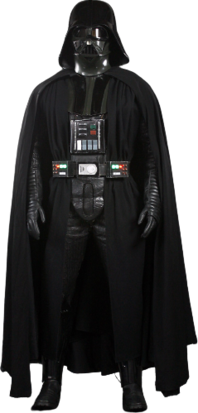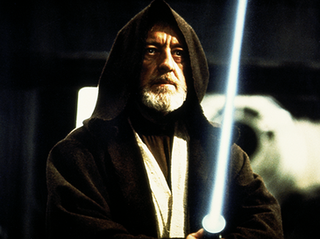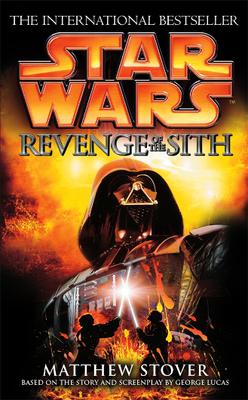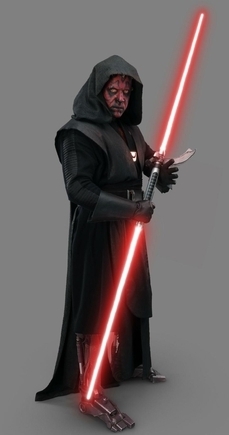
Jedi, Jedi Knights, or collectively the Jedi Order are fictional characters, and often protagonists, featured in many works within the Star Wars franchise. Working symbiotically alongside the Old Galactic Republic, the Jedi Order is depicted as a religious, academic, meritocratic, and military (peacekeeping) organization whose origin dates back thousands of years before the events of the first film released in the franchise. The fictional organization has inspired a real-world new religious movement and parody religion: Jediism.

Darth Vader is a fictional character in the Star Wars franchise. The character is the central antagonist of the original trilogy and, as Anakin Skywalker, is one of the main protagonists in the prequel trilogy. Star Wars creator George Lucas has collectively referred to the first six episodic films of the franchise as "the tragedy of Darth Vader". Darth Vader has become one of the most iconic villains in popular culture, and has been listed among the greatest villains and fictional characters ever. His masked face and helmet, in particular, is one of the most iconic character designs of all time.

Obi-Wan Kenobi is a fictional character in the Star Wars franchise. Within the original trilogy, Obi-Wan is a Jedi Master as a supporting character and is portrayed by English actor Alec Guinness. In the later-released prequel trilogy, a younger version of the character serves as one of the two main protagonists, alongside Anakin Skywalker, and is portrayed by Scottish actor Ewan McGregor. In the original trilogy he is introduced as Ben Kenobi, an alias he uses while in hiding from the Empire. He is a mentor to Luke Skywalker, to whom he introduces the ways of the Jedi. After sacrificing himself in a duel against Darth Vader, Obi-Wan guides Luke through the Force in his fight against the Galactic Empire. In the prequel trilogy, set two decades earlier, he is initially a Padawan (apprentice) to Jedi Master Qui-Gon Jinn, and later mentor and friend of Luke's father Anakin, who falls to the dark side of the Force and becomes Vader. The character briefly appears in the sequel trilogy as a disembodied voice, speaking to protagonist Rey, and serving as the namesake of Ben Solo. He is frequently featured as a main character in various other Star Wars media, including the streaming television miniseries Obi-Wan Kenobi, in which McGregor reprised the role.

Count Dooku of Serenno, also known by his Sith name Darth Tyranus, or simply as Dooku, is a fictional character in the Star Wars franchise, created by George Lucas. He is an antagonist in the Star Wars prequel trilogy, appearing in both Episode II – Attack of the Clones (2002) and Episode III – Revenge of the Sith (2005), played by Christopher Lee, as well as associated media, such as books, comics, video games, and television series. Actor Corey Burton has voiced Dooku in most of his animated and video game appearances, most notably Star Wars: Clone Wars (2003–2005), Star Wars: The Clone Wars, and the miniseries Tales of the Jedi (2022). Lee reprised the role in the 2008 animated film that launched The Clone Wars series.

Qui-Gon Jinn is a fictional character in the Star Wars franchise, played by Liam Neeson. He is a main character in the prequel film trilogy, serving as one of the protagonists of The Phantom Menace (1999). He appears briefly as a Force ghost in the 2008 animated series The Clone Wars, the season finale of the 2022 live-action series Obi-Wan Kenobi, along with Attack of The Clones and The Rise of Skywalker as a disembodied voice, with Neeson reprising his role in all of the above. Qui-Gon also appears in two episodes of Tales of the Jedi, which depicts some scenes from his life before the events of The Phantom Menace; Neeson voices adult Qui-Gon in the series, while his son Micheál Richardson voices Qui-Gon as a padawan.

Yoda is a fictional character in the Star Wars universe, first appearing in the 1980 film The Empire Strikes Back. He is a small, green humanoid alien who is powerful with the Force and is a leading member of the Jedi Order until its near annihilation. In The Empire Strikes Back, Yoda was voiced and puppeteered by Frank Oz, who reprised the role in Return of the Jedi, the prequel trilogy, and the sequel trilogy. Outside of the films, the character was mainly voiced by Tom Kane, starting with the 2003 Clone Wars animated television series until his retirement from voice acting in 2021. Yoda is an iconic figure in popular culture due to his distinct pattern of speech and role as a wise mentor.

A lightsaber is a fictional energy sword featured throughout Star Wars. A typical lightsaber is depicted as a luminescent laser sword about 3 feet (0.91 m) in length emitted from a metal hilt around 10.5 inches (27 cm) in length. First introduced in the original Star Wars film, it has since appeared in most Star Wars films, with at least one lightsaber duel occurring in each installment of the "Skywalker saga". The lightsaber's distinct appearance was created using rotoscoping for the original films, and with digital effects for the prequel and sequel trilogies.
"The Imperial March (Darth Vader's Theme)" is a musical theme present in the Star Wars franchise. It was composed by John Williams for the film The Empire Strikes Back. Together with "Yoda's Theme", "The Imperial March" was premiered on April 29, 1980, three weeks before the opening of the film, on the occasion of John Williams' first concert as official conductor-in-residence of the Boston Pops Orchestra. One of the best known symphonic movie themes, it is used as a leitmotif throughout the Star Wars franchise.

Star Wars: Episode III – Revenge of the Sith is an action video game based on the movie of the same name. It was released on May 4, 2005, for the PlayStation 2, Xbox, Game Boy Advance, Nintendo DS, and Symbian OS. For the Xbox 360's backwards compatible lineup, Revenge of the Sith is one out of the 400+ backwards compatible games for the 360. As part of the PlayStation 2 classics program, the PlayStation 2 version was re-released in Europe on the PlayStation Network on February 11, 2015, and in North America on April 28, 2015. Meanwhile, the Xbox version was also added to the backwards compatibility list for the Xbox One and Xbox Series X/S on November 15, 2021.
Lego Star Wars: Revenge of the Brick is a brickfilm loosely based on Star Wars: Episode III – Revenge of the Sith. Revenge of the Brick premiered on Cartoon Network on May 8, 2005, at 7:00 p.m. EST. The movie can now be seen in QuickTime format on the Lego website or directly downloaded. It was also released with the Clone Wars Volume Two DVD as one of its special features.

Star Wars Episode III: Revenge of the Sith – Original Motion Picture Soundtrack is the film score to the 2005 film of the same name released by Sony Classical on May 3, 2005, more than two weeks before the film's release. The music was composed and conducted by John Williams, and performed by the London Symphony Orchestra and London Voices in February 2005, with orchestrations provided by Conrad Pope and Eddie Karam. The score was Williams' sixth score in the saga. Shawn Murphy recorded the score. Ramiro Belgardt and Kenneth Wannberg served as music editors; Wannberg served as music editor for the previous Star Wars scores. A remastered version of the soundtrack was released by Walt Disney Records on May 4, 2018.

Star Wars: Revenge of the Sith is a novelization of the film of the same name, written by Matthew Stover and published on April 2, 2005, by Del Rey Books.

The Star Wars Episode I: The Phantom Menace novelization was written by Terry Brooks and published on April 21, 1999, by Del Rey. It is based on the script of the film of the same name and released with multiple covers, including Darth Maul, Obi-Wan Kenobi, Anakin Skywalker and Queen Amidala.

Star Wars: Episode I – The Phantom Menace is a 1999 action-adventure video game released by LucasArts and is an adaptation of film of the same title. The game is set in several different settings seen within the film, and takes place during the timeline of the film, with players taking on the role of Qui-Gon Jinn, Obi-Wan Kenobi, and several other characters from the film. Each playable character has a unique weapon and ability. The game features open environments to explore at the player's leisure, and dozens of non-player characters with unique dialog.

The Sith are the main antagonists of many works in the fictional universe of the Star Wars franchise. They are the antithesis and ancient enemies of the Jedi. The Sith Order is depicted as an ancient cult of warriors who draw strength from the dark side of the Force and use it to seize power by any means necessary, including terrorism and mass murder; their ultimate goals are to destroy the Jedi and rule the galaxy. The various antagonistic factions in the franchise, namely the Separatist Alliance, the Confederacy of Independent Systems, the First Galactic Empire, the Imperial Remnant and the First Order, all originated, either directly or indirectly, from the Sith.

Darth Maul, later known simply as Maul, is a character in the Star Wars franchise. He first appeared in the 1999 film Star Wars: Episode I – The Phantom Menace as a powerful Sith Lord and Darth Sidious' first apprentice. Though seemingly killed by Obi-Wan Kenobi at the end of the film, Darth Maul returned in the 2008 computer animated series Star Wars: The Clone Wars. Star Wars creator George Lucas had intended for the resurrected Maul to serve as the main antagonist of the sequel film trilogy, but these plans were abandoned when Disney acquired Lucasfilm in 2012. The character nonetheless reappeared in the 2014 animated series Star Wars Rebels and the 2018 film Solo: A Star Wars Story, voiced again by Witwer; Park physically reprised the role in Solo. Since his initial defeat in The Phantom Menace, Maul has become an independent criminal mastermind and endured as Obi-Wan's archenemy.

Mace Windu is a fictional character in the Star Wars franchise, portrayed by Samuel L. Jackson in the prequel trilogy. Jackson later reprised the role with voice only in the 2008 animated film Star Wars: The Clone Wars and the 2019 sequel film The Rise of Skywalker, whilst Terrence C. Carson voiced the character in other projects, such as The Clone Wars animated television series. The character also appears in various canon and non-canon Star Wars media like books, comics, and video games.

Star Wars: A Galactic Spectacular was a nighttime show at Disney's Hollywood Studios in Walt Disney World. The show is based on the Star Wars film series and features fireworks, projection mapping, fire, lasers, fog effects, and searchlights. During the show, Star Wars imagery is projected onto the park's Chinese Theater facade and surrounding buildings around the park's hub on Hollywood Boulevard. The show had its celebrity-filled World Premiere on Friday, June 17, 2016, replacing the park's similarly-themed display, Symphony in the Stars: A Galactic Spectacular.

"Twin Suns" is the twentieth episode of the third season of the American 3D animated science fiction television series Star Wars Rebels. The episode was written and directed by series creator Dave Filoni, with co-executive producer Henry Gilroy serving as co-writer. The episode originally aired in the United States on March 18, 2017, on Disney XD.

Star Wars: SC 38 – Reimagined is a 2019 fan remake of the 38th scene in Star Wars (1977), in which the characters of Obi-Wan "Ben" Kenobi and Darth Vader engage in a lightsaber duel on the first Death Star. It was directed by Philip Silvera, and stars stuntpeople, Dan Brown and Richard Cetrone, performing in the new footage as Kenobi and Vader respectively. It was uploaded by FXitinPost to YouTube on May 8, 2019.


















